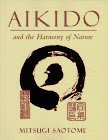In the previous post I introduced why you should bow during a training. Now there's a list of when bowing is expected.
- When you enter the dojo you bow at the door towards the middle of the room. You acknowledge the place of training.
- When you step onto the mat (tatami) you bow towards the kamiza (shrine) which is sometimes just a framed picture of O'Sensei. Some people do this in seiza (the traditional formal way of sitting in Japan) while others simply from a standing position. You show your appreciation towards O'Sensei who created this martial art. Please note that this is nothing to do with religion, you simply show your respect but it's not kind of worshipping a god.
- (When there is no space between the door and the tatami, i.e. the mat area starts right next to the door, you can bow only once.)
- When the training begins, you start with a short meditation in seiza and then first you and the master bow towards O'Sensei which is followed by a bow towards each other (students towards the sensei, sensei towards students). You may say 'onegai shimasu' (pronounced as oh-ne guy-she-mahss, you mean something like 'please teach me') when you bow towards your sensei. I don't think this needs any explanation. It is nice though that the sensei also bows towards you as he accepts teaching you and he can also learn from you during the training by correcting your mistakes or simply finding out which way of demonstrating a technique is best for students to understand how it should be executed properly.
- When the master finishes the demonstration of a technique the uke he 'used' (inappropriate, but sometimes used word) bows towards the master and says thank you (domo arigato gozaimashita). The students also bow from seiza as they were sitting and observing the master's demonstration.
- When you find a partner to train with you ask them to practice with you by going to them and bowing. You can say onegai shimasu (~ 'thank you for training with me'). Your partner accepts you by doing the same. Please note that rejecting someone is considered to be very rude and is never done unless you are to practice in pairs and two or more people bowed towards you at the very same time.
- When sensei says 'yame' (yah-meh, 'stop') or 'seiza', you finish immediately whatever you were doing (if it's possible, even in the middle of a technique except when it would cause injury, e.g. in the middle of a throw), and you bow towards each other and say thank you. You usually say this in Japanese but English, or any other language that are used by both partners, can also be accepted, you just need to show your appreciation.
- When you are practicing in groups and someone has finished his/her 'round' of being the tori (who does the technique, also called nage), s/he bows towards the next person who will take his/her place. If it's the first round, the order is usually from senior to junior (so that beginners can observe the technique more before actually doing it), if it's not the first round you should use your memory to remember who's next :).
- Some people bow towards each other after every uke-tori swap (usually after four techniques, two each side). In our dojo this is not practiced (probably to save time), we only bow when we are asked to take our place in seiza or change partners.
- When you don't understand anything and want to ask the sensei, I think you know what to do: bow :). But the most important thing is that you should go to the sensei and bow and not hail him like a taxi and when he comes to you, bow :). You do the same when you need to leave the room for whatever reason or need to stop for a while. This includes drinking some water which you should do only for a very good reason during trainings (e.g. in 65 degrees Celsius :)).
- At the end of the class, the same meditation-bow-bow procedure is followed as at the beginning of the training.
- Similarly, when you leave the tatami and dojo you do the same bows as when you were entering. This way you will use the same procedure to get back to the civil world as to forget about your daily problems when entering the dojo.
- If you are not training but watching the class, you also bow when entering and leaving. Apart from these, you only need to bow when the others, after the meditation, bow at the beginning and end of the class. During the meditation part you should stand up as another sign of respect.
This may sound many if you are a beginner but you will soon find it natural.
If I left something out please let me know in the comments, otherwise bow whenever you feel it is appropriate in reflection of the above points. :)










No comments:
Post a Comment